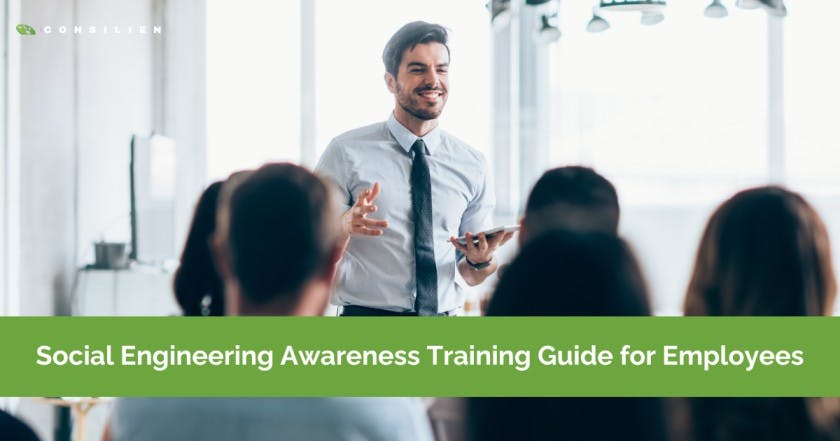Social Engineering Awareness Training Guide for Employees

Attackers don’t hack systems first, they hack people. In 2025, phishing and pretexting remain top causes of costly breaches. This guide gives your team a simple, repeatable training plan to recognize and report social engineering across email, text, voice, and video.
Table of contents
- What counts as social engineering (in 2025)
- The 8-part training plan (with templates)
- Reporting playbook & metrics that matter
- Scenario library (email, SMS, voice, deepfakes)
- Compliance mapping (NIST/ISO)
- FAQs
What counts as social engineering (in 2025)
- Phishing: Email lures to steal credentials or push malware (now often AI-authored).
- Smishing: Fraud via SMS/MMS (e.g., fake toll notices); FBI/IC3 issued PSAs in 2025.
- Vishing: Phone calls/voice notes—now with AI voice cloning of executives/officials.
- Pretexting/BEC: Impersonation to rush payments or data. DBIR highlights social attacks as major breach causes.
Our key takeaways: Assume the message looks legit and sounds human. Verify out-of-band before acting.
The 8-part training plan (step-by-step)
- Kickoff & policy baseline (Week 0)
Remind staff: never approve money/credentials based solely on email/DM/voice—call back on a known number. Provide Acceptable Use and reporting policy links.
Our key takeaways: Clarity reduces “I wasn’t sure” clicks. - Micro-learning cadence (Once Every Two Weeks or Monthly)
5–8-minute modules on phishing, smishing, vishing, QR lures, MFA fatigue.
Our key takeaways: Short + frequent beats annual marathons. - Quarterly phishing simulations
Include QR code, callback (phone-based), and payloads matching your business apps. If you have Microsoft 365 E5 or Defender for Office 365 Plan 2, use built-in Attack Simulation Training.
Our key takeaways: Simulate what’s hitting you right now. - “Stop, Verify, Act” workflow
Teach employees to pause, verify via another channel, then act. Provide no-approval-over-live-calls rules for payments.
Our key takeaways: Out-of-band is your superpower. - One-click reporting & positive culture
Use a report-phish button and a hotline. Celebrate reporters; avoid shame-based comms.
Our key takeaways: Reporting early saves money. - Targeted coaching for repeat-clickers
Short, contextual training tied to the user’s behavior; don’t rely on generic annual courses.
Our key takeaways: Personalized nudges change behavior faster. - Executive & finance scenarios
Train approvers/AP on invoice fraud, vendor bank change scams, and voice deepfakes. FBI/IC3 alerts note impersonation campaigns.
Our key takeaways: High-risk roles deserve extra reps. - Measure & improve quarterly
Metrics: phishing report rate, median time-to-report, click rate, and repeat-clicker count. Align to NIST AT-2/AT-2(3) literacy and social-engineering training controls.
Our key takeaways: What gets measured gets safer.
Reporting playbook (make it obvious)
- If it’s suspicious: Don’t click/reply. Use the report button or forward to your abuse mailbox.
- If approvals or payments are requested: Call back on a directory number; never on the number in the message.
- If you clicked: Report immediately; faster containment reduces breach cost (global average $4.44M, U.S. average $10.22M in 2025; faster ID/containment lowers cost).
Our key takeaways: Speed to report is a controllable cost lever.
Scenario library (use in training & sims)
- Email pretext: “Urgent DocuSign” from HR; misspelled domain → report; verify in HR portal.
- Smishing: “Unpaid toll” link; FBI warned of these—delete/report.
- Vishing: “CFO on a flight—wire now”; policy: no approvals on live calls—use out-of-band callback.
- QR phishing (quishing): Code on lobby poster → login page; never scan unknown QR codes for corporate logins.
- Deepfake voice/video: Exec requests gift cards; verify via Teams/phone directory, not the calling number.
Our key takeaways: Train to your actual risks and channels.
Compliance mapping (NIST/ISO)
- NIST SP 800-53 r5 AT-2, AT-2(3): literacy training plus specific social-engineering awareness/reporting.
- NIST SP 800-50 Rev.1 (2024): lifecycle approach to learning programs (design→develop→implement→measure).
- ISO/IEC 27001:2022 Annex A 6.3 & Clause 7.3: periodic awareness, role-based training, and competence verification.
Our key takeaways: Document cadence, completion, assessments, and improvements to satisfy audits.
Need a rollout with content, phishing sims (including Microsoft 365 AST), and board-ready reporting? Consilien’s Security Awareness Training and Compliance programs can stand up your program in weeks.
Social Engineering Awareness Training FAQs
How often should we train?
Monthly or Bi Weekly micro-lessons + quarterly simulations outperform annual-only training.
Do we need vishing/smishing content?
Yes, 2025 PSAs highlight text/voice impersonation (often AI-assisted).
What is the fastest way to verify a request?
Out-of-band callback using a known directory number- never numbers in the message.
Can Microsoft 365 cover phishing simulations?
Yes, with E5 or Defender for Office 365 Plan 2 you have Attack Simulation Training included.
Which metrics prove training works?
Rising report rates and faster time-to-report, with declining click rates and repeat-clickers.